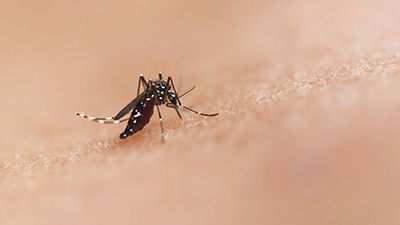Parasites Affect Behavior of Moths
Gypsy moth virus packs a weapon of mass dispersion.
News Source
- Nature: “How gypsy moth is kept high to die”
Parasites affecting behavior seem like sci-fi. Yet fungi that turn ants into obedient zombies1 and parasitic Toxoplasma2 that makes rats lose their fear of cats are strange realities. The gypsy moth caterpillar is a viral victim that dies in the optimal location to spread its attacker far and wide. The question has been, “Why?”
Researchers from Penn State and Harvard have uncovered the gene behind this gruesome reality. Gypsy moth caterpillars normally munch leaves in the tops of trees at night and descend to hide during the day and also to molt. But caterpillars infected with baculoviruses, “just before death, . . . climb to the top of their host trees to die, liquefy, and release millions of infective virus particles, with dispersal facilitated by rainfall.”3 Baculovirus infection is aptly called “tree top disease.”
Since the virus affects climbing behavior, Kelli Hoover’s team hypothesized that the virus deactivated a hormone that triggers molting. Hormones, because they normally have a number of related effects in an organism, would be the logical targets for behavior-affecting parasites.
Not being hormonally prompted to stay in the bottom of the trees, the caterpillar climbs to the treetops, dies, and rains its deadly viral load upon a large cohort of its neighbors.
The team confirmed that the virus carries a gene called egt. This gene encodes for an enzyme that deactivates the molting hormone. Not being hormonally prompted to stay in the bottom of the trees, the caterpillar climbs to the treetops, dies, and rains its deadly viral load upon a large cohort of its neighbors.
To test their hypothesis, the team infected caterpillars with normal baculoviruses and with viruses minus their egt gene. Those affected by egt imitated the high altitude death by climbing to the tops of their tall plastic bottles. Those infected with defective viruses stayed in the bottom to die.
The finding is most significant because it demonstrates a genetic mechanism by which “extended phenotype” can be expressed. The term extended phenotype was coined by evolutionist Richard Dawkins. The term refers to the fact that while a gene can only code for production of a protein, the extended phenotype for that gene should rightly include all effects that the gene has on all organisms it affects.
“Interfering with the hormonal system is the most elegant way to influence complex traits such as behaviour,” says Hoover. Leeds Parasitologist Glenn McConkey agrees, “For a parasite gene to affect something as complex as host behaviour, it must be modifying something neural and that means either hormones or neurotransmission.”
David Hughes, who has also worked with zombie ants, says, “To me this moves the concept of the extended phenotype forward in quite a dramatic fashion. This is the first empirical evidence that a gene in the body of one organism can have a direct effect on another organism.”
While Dawkins considered the concept to be his great contribution to evolutionary theory, the concept actually relates to natural selection of organisms. No new kind of organism is coming into existence. Natural selection is optimizing parasitic opportunities by “rewarding” the most effective dispersal strategies.
We can be confident, based on God’s declaration, that the original Creation was very good. In the beginning therefore there were no dissolving caterpillars dripping their disintegrated parts on the forest below. But viruses, acting as vectors to facilitate the exchange of bits of genetic information, would have helped microorganisms adapt to changing conditions and survive to fulfill their complex ecological roles.
In a world gone wrong after the Fall and the Curse, a combination of mutations, horizontally transferred genes, environmental changes, and host changes have left us with a number of harmful viruses and other microorganisms. But no new kinds of organisms are evolving. The infected caterpillars are still gypsy moth caterpillars and the baculoviruses are still baculoviruses. Natural selection operating on the extended phenotype is nicely demonstrated, but no evolution is happening.
Further Reading
For More Information: Get Answers
Remember, if you see a news story that might merit some attention, let us know about it! (Note: if the story originates from the Associated Press, FOX News, MSNBC, the New York Times, or another major national media outlet, we will most likely have already heard about it.) And thanks to all of our readers who have submitted great news tips to us. If you didn’t catch all the latest News to Know, why not take a look to see what you’ve missed?
(Please note that links will take you directly to the source. Answers in Genesis is not responsible for content on the websites to which we refer. For more information, please see our Privacy Policy.)
Footnotes
- Parry, Wynne. “How Zombie Ants Lose Their Minds,” LiveScience.com, May 8, 2011, www.livescience.com/14064-zombie-ant-fungus-parasite.html.
- Harder, Ben. “Parasite ‘Brainwashes’ Rats Into Craving Cat Urine, Study Finds,” NationalGeographic.com, April 3, 2007, news.nationalgeographic.com/news/2007/04/070403-cats-rats.html.
- Hoover, K. et al. 2011. A Gene for an Extended Phenotype. Science 333, no. 6048:1401.
Recommended Resources

Answers in Genesis is an apologetics ministry, dedicated to helping Christians defend their faith and proclaim the good news of Jesus Christ.
- Customer Service 800.778.3390
- Available Monday–Friday | 9 AM–5 PM ET
- © 2025 Answers in Genesis





